Production Designer Henry Bumstead Interview |
Read more at in70mm.com The 70mm Newsletter |
| Written by: Transcription, literal, but "fixed", via Android phone, initial version, created March 4, 2023. | Date: 01.02.2024 |
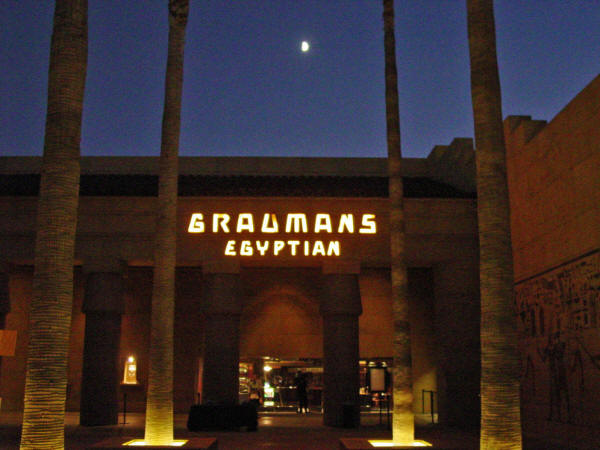 Egyptian
Theatre, Hollywood, USA in 2004/05. Picture by Paul Rayton Egyptian
Theatre, Hollywood, USA in 2004/05. Picture by Paul RaytonMod: (moderator, Dennis Bartok) [.... He is the] Academy award-winning production designer of "To kill a Mockingbird", "The Sting", "Unforgiven", "Million Dollar Baby", "The Man Who Knew Too Much" ... more films than we can list. Please join me in welcoming Mr. Henry Bumstead. [applause] A: (This is what happens when you get 90 years old.) See that film? 50 years old! Just think -- Unbelievable. Unbelievable. 50 years old. Mod: It looks better than ever! A: It looks good. Well, you can't miss -- you have a good director, and a good story and good actors. Mod: That's one that was "built to last". Flawless. Amazing. A: Good music, fantastic music, hmm? [applause] I might like to say first, when you go see a Hitchcock picture, everything that's shot outside is outside, but everything else is a set. Practically everything in this picture is a set, built on the stage, because Hitch [Director Alfred Hitchcock - ed.] liked the comfort and the and the ... he could handle things on the stage, get good things out of his people. So whenever you see a Hitchcock picture, there are a few exceptions where we shot actual locations, but basically they're all sets on the stage. Mod: I wanted to start by going back a little bit before "Vertigo", how did you first get involved in the film industry? Had you always dreamed of working in the movies since you were young? A: No, I wanted to be a cartoonist, and I always liked to draw. And, ah, I went to Chaffey high school in Ontario, California -- not too far from here -- and so I was a good football player and good at the high hurdles so this [motioning to his physical limitations - ed.] is kind of, I think, the results of it. and so I was I was rushed [recruited - ed.] by quite a few of the naval academy wanted me to go there and then California and Iowa quite a few schools, but I chose SC [University of Southern California - ed.] because it was not only close to home but they had a good college of architecture and fine arts, and so that was a great decision because, after I got hurt my freshman year in football and my sophomore year in then in track, I decided to get an education and that summer I was invited to work on a film and Jack Martin Smith who was an SC boy was working on the "The Great Ziegfeld" and when they had finished that, and so he recommended me, and so once I saw the studio work I decided that's what I wanted to do rest of my life is in work in film and so here I am after I think I've had a steady a 67 years in the film business and [applause] thank you it's been wonderful I hope everybody here wants to be in the film business. Mod: And I know you've told this story many times before; I'll ask you to tell once again: A: Well, I was working with them I was working on a picture -- "Vagabond King" -- it's a a Gothic picture, really tough, and they and the director was Michael Curtiz. and I never realized that the cameraman on that picture was Bob Burks, Hitch's cameraman, and then I never even thought about it or I didn't know and apparently Hitch asked Bob Burke's do you know of any young art directors you think I'd like to work with, and he said yeah I'm working with one right now, and Hitch said send him up. Well, I went up to see Hitch and then hit it off fine with him and did his first picture in England and in Africa, "The Man Who Knew Too Much". and in my ... I never thought I'd ever work for -- my gosh! -- to work for Alfred Hitchcock! It was beyond my dreams, but it all worked out and I loved working for him. |
More in 70mm reading: in70mm.com Interview & People Restoration of "Vertigo" Ken Annakin 90th Birthday Salute Robert Wise and talent's introduction to "The Sound of Music" Hollywood's Egyptian Theatre Exteriors, 2004/05 in70mm.com's Library Presented on the big screen in 7OMM Peripheral Vision, Scopes, Dimensions and Panoramas |
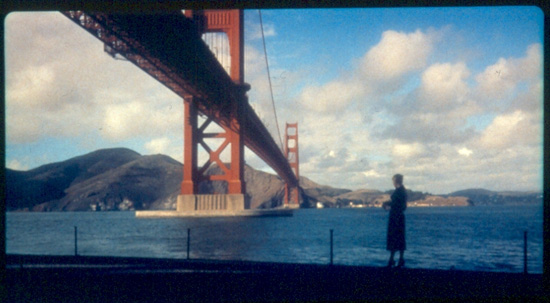 Fort
Point, beneath the Golden Gate Bridge, Marine Drive, San Francisco Fort
Point, beneath the Golden Gate Bridge, Marine Drive, San FranciscoMod: Do you remember what your first thoughts were when you read this script for "Vertigo" and and your initial conversation with with Hitchcock about the overall ... A: Oh, I'm sure when I read it, I thought it was a very good script, and you know, Hitch always had two or three things in mind on the picture that that he was very determined to have, and he left the rest up to you. One of them was that he wanted Jimmy Stewart's house to overlook Coit Tower. And so I had no idea. Well, I found this house, but it was owned by an Oriental person and he wouldn't let me change a thing on it and so it's very very Oriental House -- but it it worked fine, because it had Coit tower in the background. Shortly before Hitch passed away, I used to stop by his office and see him, and so one day he asked me, he said "You know why I insisted on having Coit tower out there through through his window, and also out on the steps?" I said, "Hitch, I have no idea." He says, [mimicking Hitchcock's voice] "It's a Phallic symbol"! [laughter] Isn't that wonderful? God bless him. Mod: When you when you start working on a picture, and you first approach the challenge of production design for a film, do you think in terms of the the overall picture, do you thinking broad strokes or do you start thinking in terms of specifically ... ? A: I go through it and kind of think, what should be sets maybe, and what should be location and no I look at it overall and I guess I've done over a hundred feature films, so it's a ... now I'm working with with Clint Eastwood, and he's just marvelous to work with. you know. and it's just I'd never have worked till 90 years old if it hadn't been for for Clint but I have a great relationship with him and I have a great team a couple of them are here tonight Jack -- where are you Jack? Jack Taylor, Adrian Gordon stand up -- [applause] they work with me all the time, and they they make my job very easy, especially now that I'm kind of crippled, you know? They do all the work, I'm, I'm just to get the credits [laughs]. Mod: In many of your other films, and I'm thinking of "To Kill A Mockingbird" or "The Sting", certainly "Million Dollar Baby" and "Unforgiven" ... one of the great things is how weathered the the look of the film is, it feels incredibly lived-in. "Vertigo" is a very different feel, there's a kind of timeless feel is almost as if everything is under glass. Were you very conscious of that? Was that something that Hitchcock wanted for "Vertigo"? A: Oh, gee, that was 50 years ago ... I don't think so, no. I think it's just I just did sets the way I thought they should be, and people have always asked me about color. I have no particular system of color or anything, I just paint things the way I think they should be, and fortunately I've been very lucky that way. |
|
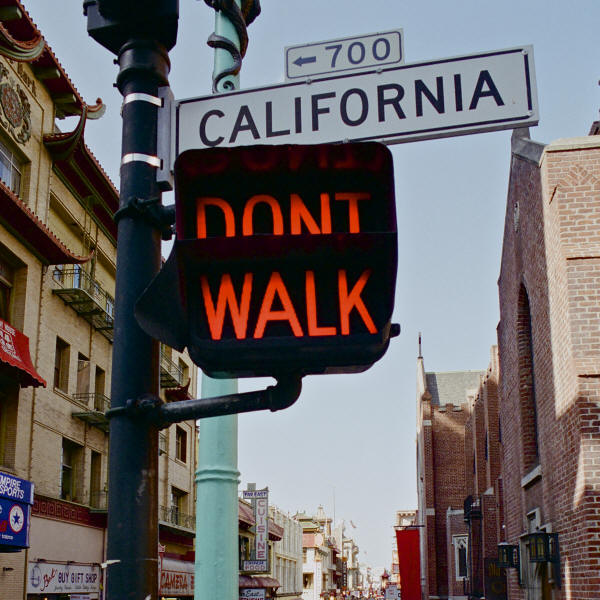 "Dont
Walk" San
Francisco style. Picture: Thomas Hauerslev "Dont
Walk" San
Francisco style. Picture: Thomas HauerslevMod: There's an incredible sense of mystery in this film in particular, in this overwhelming sense of nostalgia for the past. Again, is that something that that you and all of the other people working on the film were acutely aware of? We see the film now, and it all seems to blend so beautifully: Bernard Hermann's score and you get the different costumes ... was there the sense that this was something other than s just a sort of usual mystery or thriller, even for Hitchcock? A: It's it's a real I think you know I just think it was a terrific story, and anyways and I had just good help all around, you know, everybody. I mean, you just look -- the music and and the costumes, everything, you know, it's just so it made my job, you know, I think fairly easy, really fairly easy. I can't remember that I had any trouble at all with this picture with the with Hitch. I mean it's just went very smooth. Mod: they're amazing scenes and sequences of the California coastline. I think of Fort Point [location in San Francisco - ed.] that ... how involved were you in those choosing those the exterior locations? A: They were all in the script. Everything was in the script and so like Ernie's restaurant and all those they were all sets, you know, all sets. I think the only one that wasn't a set maybe at the McKittrick hotel, I think the lobby that was an actual building, and I built a desk there and that and then key rack and everything to make it look like a hotel you know, and so it's, it's just fun. Mod: And there's been a lot of talk over the years that Hitchcock so the very famously had everything planned out meticulously ahead of time. He said the real work was, a you know when I'm doing the storyboards and then, yeah, the shooting is almost after the fact. Was that your sense? Were there any times when he would improvise, or he would change things ...? A: I think you pretty well knew what he was going to do. I ... You figured Hitch did about two pages [of script - ed] a day, that was that was his [speed of shooting - ed]... and it was wonderful because Hitch always came in late, about 9:00[am], and we always had to leave room wherever we built sets so [his] car could drive right in on the stage. And he always sat in the front seat with the driver, and then he'd get out and walk about six steps to his chair, and sit down. and so I would always ask the driver, I said that especially if I wanted to okay some sets or something, no cuz we'd show him drawings -- of how Hitch was feeling. You know if people didn't think he was feeling too well, I'd, ... if I could, I'd wait till the next day to just show him the plans, but as I say we always had to leave room for that car to drive drive on the stage. Mod: Do we have any questions from the audience? Right in the back [inaudible question from audience] A: Well .. we didn't ... I can't remember ... every storyboarding. Maybe once or twice for Hitchcock. Clint Eastwood you don't you know you don't have to do ... he understands plans, and you don't have to show him anything really. I mean, he trusts me and I I pick the locations and me, he may look at a few of them and others he doesn't look at, and then may doesn't see them till he gets there, but he's very clever with the camera, and the camera movements, and so he makes everything look pretty good. Q: [inaudible question from audience] A: "Million Dollar Baby" was all done around Los Angeles here, and all all I'm really on local locations except "The Hit Pit". "The Hit Pit" was an old ... some warehouse building or something in Los Angeles, and so when we, you know, we have Location Departments and that somebody showed me pictures of this place and I thought this would make a great hit pit so I showed it to Clint and he said, "Bummy, I'd like to look at it." So apparently he went down and looked at it and gave me a call and he says "Oh that's perfect". So then we went ahead and did all the interior design. His office put his office up high in the place where Morgan Freeman lived in the rings, and and everything. And have a very good decorator, Dick Goddard, did a beautiful job of decorations in the place, and most of the picture took place there. But everything else was really locations around town that we repainted, or or redressed, or did things to to accompany the script. But it's it's ... in fantastic: who would ever think that you can do a picture of a woman boxer? Can you believe it? And be such a success?! Well that's that's Clint Eastwood. I mean, he's one very very good director and he's getting better every time, and it in his next project is about "Flags Of Our Fathers" -- it's about all about Iwo Jima. Can you imagine? And it's a tough one, so I'm going to need a lot of help on that, I tell ya! |
|
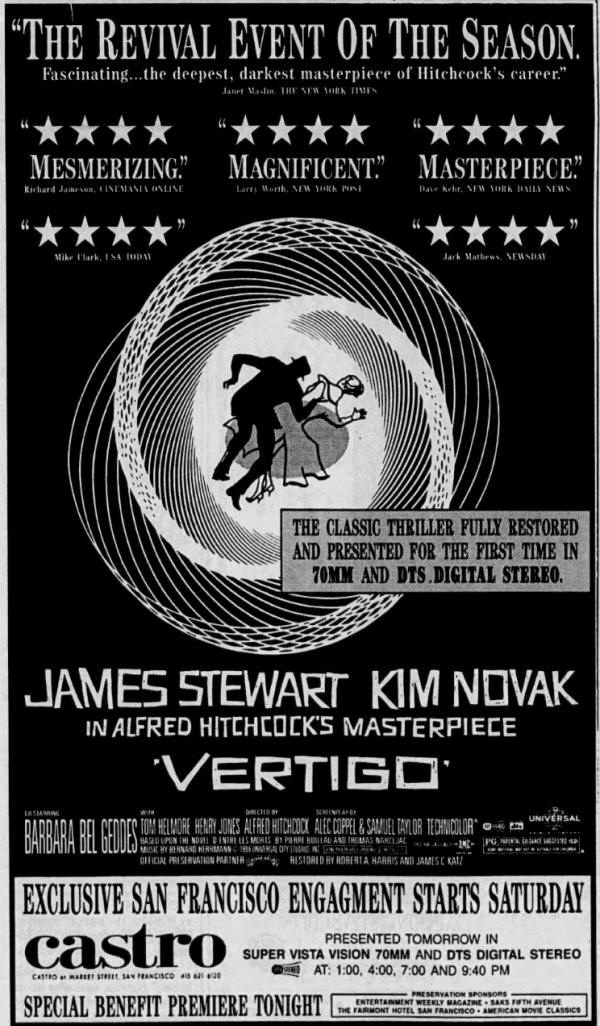 Q: [inaudible question from audience] 16:20 Q: [inaudible question from audience] 16:20A: It's this is a wonderful film. I just it's just incredible how well it's done. It's just before that "Mystic River", that we made in the in Boston. Fantastic film. Clint's a wonderful director, I'll tell ya, and and I have a great relationship with him and Jack Taylorm who works with me, my art director, and he knows Clint too. We know what he likes, and he's just fun to work with. I would have never -- I'm 90 ... I'll be 90 years old March 17th and [applause] ... thank you -- I would never never have worked this long if it hadn't been for Clint Eastwood, but he he's just fun to work with. You ... I tell you, you get up in the morning, and you can't wait to get to the set, to see what he's going to do with it. It's just, he's a joy. Q: [inaudible question from audience] 17:30 A: A lot of those were .... some of them are rear projection, and the others were ... I can't think of the name of them [aside: "What are they, Jack?"] of the now Translights, yeah Translights. Yeah that most of them were translights and shot on location. [see description of process photography system "Translights" at: https://en.wikipedia.org/wiki/Translight - Ed.] Q: Yeah yeah right there in the middle [question inaudible] 18:19 A: "To Kill a Mockingbird" was all done on the Universal back lot. Everything. And I built it all there. It's unbelievable huh. It's just it was, it was, I think it was, a great contributor to the picture. The street just looked fantastic. I had a great cameraman, Russsel Harlan who did a beautiful job of lighting, one at night and then photographing during the day, and I think the the courthouse ... I can't remember the interior of the courthouse? ... No, we built that too, as I remember. And it's a wonderful picture. I think I think that picture will live forever. I mean it's just ... it solves the questions between blacks and whites. I think it's beautiful. Q: [inaudible question from audience] 19:20 A: Well you know I I haven't really I haven't really had any pictures now. but I mean there's so many things you can do now, computer graphics and everything, and so I haven't gotten into that now but I mean you can do wonderful things now that we couldn't do in the past, and the sky's the limit. yeah it's just just to do so many things. Q: [inaudible] Yes. George Roy Hill, one of my favorites. I did eight pictures with George, and "The Sting", and then the one of my favorites, "A Little Romance", and he he was a fantastic director. and I did my first picture with him was a picture called "Slaughterhouse Five" that we did in we did in Prague, you know is when Prague was full of Russians. But I think he ... it's just a marvelous picture, but it's really one of my favorite pictures, "Slaughterhouse Five", and he was just wonderful to work with, and then I'm sorry that he passed away so soon Q: [inaudible question from audience] 21:00 A: on the picture [we seen this evening is] we saw this evening of "Vertigo", no I didn't know. Mod: Did you have any interaction with Saul Bass, during the making of "Vertigo"? A: No he was ... that was Saul Bass, and he did a marvelous job with it, didn't he? I mean he's fantastic. It's a great, great introduction to the film, and that and that was with Hitchcock's idea I guess, with Saul Bass. I had my hands full doing the sets; believe me, I didn't have to worry about that. [chuckles] Mod: I have to say it's a great honor to be here with you and to have enjoyed your artistry for so many many years, and hopefully many years to come, Mr. Henry Bumstead. [applause] |
|
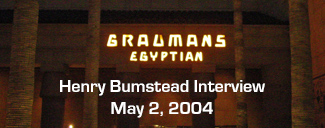 • Go to Production Designer Henry Bumstead Interview |
|
| Go: back - top - back issues - news index Updated 22-01-25 |
